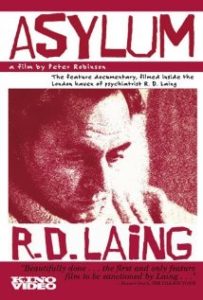 This 1972 documentary looks in on a most unique method of psychological treatment. An example of the alternative therapy craze of the sixties, the treatment on display in ASYLUM was a continuation of Kingsley Hall, an experimental community founded in 1965 by psychoanalyst R.D. Laing. Its setting is a rented house in London, whose inhabitants are all insane but for a couple of smooth talking psychiatrists tasked with looking after things. This film was made by producer-director Peter Robinson and cameraman/editor Richard W. Adams, who spent six weeks ensconced inside the house in question.
This 1972 documentary looks in on a most unique method of psychological treatment. An example of the alternative therapy craze of the sixties, the treatment on display in ASYLUM was a continuation of Kingsley Hall, an experimental community founded in 1965 by psychoanalyst R.D. Laing. Its setting is a rented house in London, whose inhabitants are all insane but for a couple of smooth talking psychiatrists tasked with looking after things. This film was made by producer-director Peter Robinson and cameraman/editor Richard W. Adams, who spent six weeks ensconced inside the house in question.
It opens with Laing discussing his theories about mental illness, claiming that the traditional insane asylum setting is not therapeutic, with his preferred method of therapy being, simply, “live and let live.” There’s no real treatment in Kingsley Hall, nor any officially decreed release period. All its inmates are there voluntarily, and all are required to pay rent.
The film is initially quite scattershot in its presentation. We see a shirtless middle-aged man holding court and annoying the hell out of his fellow internees; a bearded man discusses how he’s desperately tried to avoid “the terror” that grips him; a young woman mentally regresses to an infant state, a process the head shrink claims she’s “come through very well”; a guy chats with a group of children with whom, it seems, he has a lot in common mentally; a woman sings a song that degenerates into a lot of anguished wailing; a man breaks down while describing how he beat up his wife.
A narrative of sorts materializes in the final third as resentment is aired against David, an especially temperamental patient who is believed by his increasingly resentful fellows to be the lynchpin around which the asylum revolves. David grows hostile at the criticism, and becomes quite violent. Following Laing’s methodology, David and the others are left to work out this quandary on their own, in a group discussion that, in the film’s most powerful sequence, gives way to arguing, crying and much anguished soul bearing.
ASYLUM is alternately strangely absorbing and deadly dull (the sight of a mentally ill person droning on, which is something we get a lot of here, is about as scintillating as it sounds), with filmmaking that’s smooth and considered at certain times and quite clumsy in others (as in an interview whose flow is broken by a sudden camera zoom). Yet there are some lyrical moments, as in a slow pan through the house at night during an off-screen freak-out by David, and genuine tension and excitement in the climactic group encounter session.
There’s no music or narration, with the tone kept studiedly neutral. In this respect the film closely resembles those of the pioneering documentarians Frederick Wiseman and Allan King, and indeed bears a more-than-passing resemblance to Weisman’s TITICUT FOLLIES and King’s WARRENDALE, both of which, like ASYLUM, are concerned with questionable-by-modern-standards treatments of the mentally ill. ASYLUM is the least known of the three films but deserves greater recognition, as a fascinating curiosity if nothing else.
Vital Statistics
ASYLUM
Peter Robinson Associates
Director: Peter Robinson
Producer: Peter Robinson
Cinematography: Richard W. Adams
Editing: Richard W. Adams
Cast: R.D. Laing, Leon Redler, David Bell, Julia
